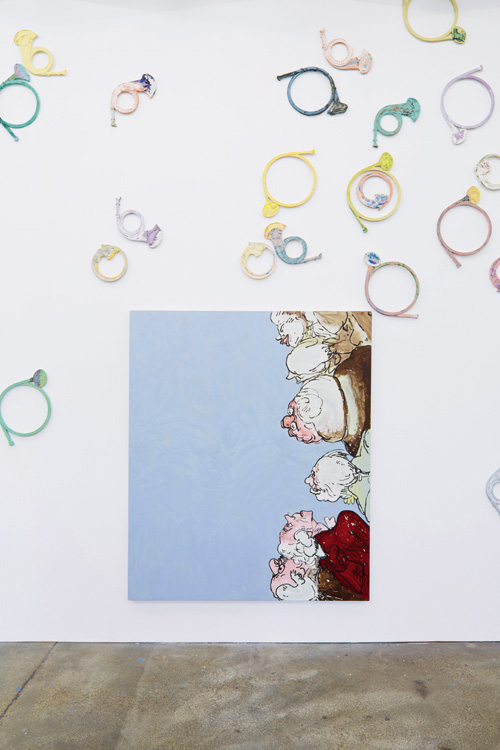
- Source: FRIEZE MAGAZINE
- Author: CHLOE STEAD
- Date: AUGUST 12, 2015
- Format: PRINT AND DIGITAL
Charlie Billingham
Supportico Lopez, Berlin, Germany

Charlie Billingham, Schaulust, 2015, installation view
The suggestive bums, tums and legs of Charlie Billingham’s previous output seem to have changed shape in the painter’s first solo exhibition at Supportico Lopez. If one was previously invited to ogle at the robust bellies and round behinds of Billingham’s grotesques, here it is they who do the staring. Inspired by caricaturists such as Thomas Rowlandson and James Gillray, Billingham’s characters – with their breeches, monocles and powdered wigs – seem straight out of the 18th or early 19th century. In that age, the flourishing theatre and opera houses were places to see and be seen, for showcasing new fashions and spreading gossip: the perfect place, then, to enact the Schaulust(‘scopophilia’) of the exhibition’s title.
In each of the four large paintings that grace the back wall of the gallery, a group of men gazes intently in the same direction. In Enlightenment (all works 2015) and Curtains Upthe men are gathered in the bottom right-hand corner of the painting. In Scopophilia and The Show Must Go On, though, they run along one side like a border, as though the canvas were painted horizontally and turned anti-clockwise. The figures seem to stare at nothing but an expanse of blank colour, but the knowingly clichéd titles (The Show Must Go On) make clear that they are spectators at the opera or theatre.
Billingham’s previous works foregrounded the eroticism implicated in acts of spectatorship. In this new series, though, the viewer is left to decipher emotion from the characters’ facial expressions. Are they lustful, mesmerised or merely coolly interested? Surrounding the paintings, flattened horn-shaped forms made from jesmonite and painted in bright acrylic were mounted on the gallery walls. The genesis of this eruption of musical instruments is suggested on one adjoining wall: six smaller paintings, each depicting a man in a closely cropped profile, are arranged horizontally, four of which are overlaid onto a woven tapestry. One horn is lined up so that it seems to be played by a figure, suggesting that the horn-shaped reliefs on the walls are remnants of that action. While the horns add an almost orgasmic energy to the room, the layering of the paintings with the tapestry feels slightly forced. The London-based artist has often created installations by printing or spraying directly onto the walls behind his paintings to great effect, but here the woven tapestry contributes neither to the surrounding paintings nor to the installation as a whole.

